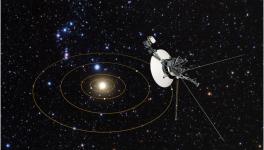2I/Borisov, the First Interstellar Comet to Have Visited our Solar System

There is a new visitor to our solar system, an interstellar comet named 2I/Borisov. Importantly, scientists believe that it is a comet which has never passed near a star until it came close to our own.
2I/Borisov was first detected in 2019 when it came close to the solar system. Researchers found that 2I/Borisov came from an interstellar space and its behaviour nearly confirms that it is a comet. Prior to this comet, another celestial object from interstellar space, the Oumuamua – a pancake shaped object – had been detected.
What is Interstellar Space?
“Scientists define the beginning of interstellar space as the place where the sun’s constant flow of material and magnetic field stop affecting its surroundings. This place is called the heliopause. It marks the end of a region created by our sun that is called the heliosphere,” NASA wrote, defining interstellar space.
The heliosphere is created by a constant flow of particles and a magnetic field created by the sun, its speed flow is around 670,000 miles per hour. This stream of flow is called the solar wind.
The solar particles inside the heliosphere are hot but they are in lesser concentration. Outside this sphere the particles become colder and more concentrated. This marks the beginning of interstellar space. Here, the number of cold particles increases and the magnetic field from the sun no longer exists. However, there would be a magnetic field originating from another star in interstellar space.
What is a Comet?
Again, according to NASA, comets can be defined as “frozen leftovers from the formation of the solar system composed of dust, rock and ices. They range from a few miles to tens of miles wide.”
When a comet comes near the sun, it gets heated up and can throw gases and dust which appear as a glowing head, the size of which can be larger than a planet. This process forms a tail that can stretch for millions of miles.
Scientists have discovered two new ways that 2I/Borisov is different from any other known comets. The findings were published in two papers, one in Nature Communication and the other in Nature Astronomy, on March 30.
In one of the studies, scientists used the European Observatory’s Very Large Telescopes (VTL) located in the Atacama Desert, Chile. They analysed the scattering of light from the dust particles in of 2I/Borisov's coma – the enveloping of dust and gas that surrounds the core of the comet. The scientists found that the light from the coma was very polarised. This suggested that the comet could be more pristine than others and that it has not been affected by particles from gas clouds and energy since it has not passed near a star.
Prior to this the only other comet that has polarised light was Hale-Bopp, which appeared in 1997. “Hale-Bopp rarely went close to the sun. We think that before its apparition in 1997, it did it only once, about 4,000 years ago, so the material at its surface, when we observed it, was only slightly processed by the sun,”said Stefano Bagnulo, an astronomer at Armagh Observatory in Ireland and the lead author of the first study.
Alberto Cellino, a researcher from the Astrophysical Observatory of Torino, Italy and an author of the first study, was quoted saying: “The fact that the two comets are remarkably similar suggests that the environment in which 2I/Borisov originated is not so different in composition from the environment in the early solar system.”
The other paper published in the journal Nature Astronomy basically showed that 2I/Borisov has experienced gravitational stirring. It happens when gravity acts on a passing body and stirs up the material.
The detection of the new comet is important in our understanding of the formation of the solar system. Comets like 2I/Borisov, which have not passed close to the sun, are of special interest, because the material they are made up of is the same as when the solar system had been formed.
Get the latest reports & analysis with people's perspective on Protests, movements & deep analytical videos, discussions of the current affairs in your Telegram app. Subscribe to NewsClick's Telegram channel & get Real-Time updates on stories, as they get published on our website.
















